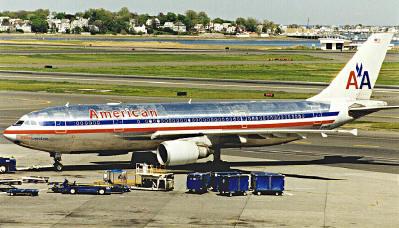Wed, Nov 21, 2012
Requires Modifications To Rudder Control System Or Installation Of Rudder Stops
The FAA has issued an Airworthiness Directive predicated on an incident which occurred 11 years ago. The AD (2012-21-15) applies to all Airbus Model A300 B4-600, B4-600R, and F4-600R series airplanes, and Model A300 C4-605R Variant F airplanes (collectively called A300-600 series airplanes); and Model A310 series airplanes.

According to the FAA, the AD was prompted by "events of excessive rudder pedal inputs and consequent high loads on the vertical stabilizer on several airplanes. This AD requires either incorporating a design change to the rudder control system and/or other systems, or installing a stop rudder inputs warning (SRIW) modification. We are issuing this AD to prevent loads on the vertical stabilizer that exceed ultimate design loads, which could cause failure of the vertical stabilizer and consequent reduced controllability of the airplane."
The event in question was an accident which occurred November 12, 2001, in which the tail of an American Airlines A300-605R came apart shortly after takeoff from JFK airport in New York. The airliner went down in a populated area, resulting in the fatal injury of all 260 people on board the plane, as well as five on the ground.
In its probable cause report, the NTSB said that the cause of the accident was "the in-flight separation of the vertical stabilizer as a result of the loads beyond ultimate design that were created by the first officer's unnecessary and excessive rudder pedal inputs. Contributing to these rudder pedal inputs were characteristics of the Airbus A300-600 rudder system design and elements of the American Airlines Advanced Aircraft Maneuvering Program."
Since the accident, Airbus has issued several service bulletins addressing the issue. The estimated cost of installing a system to warn pilots that they are using excessive rudder forces is between $72,720 and $107,720 per airplane. Installing a system to limit rudder travel would be as high as $195,500 per airliner. The FAA estimates that there are 215 aircraft registered in the U.S. that are affected by the AD. The FAA says that the modifications must be made within 48 months of the AD's effective date of December 14. USA Today reports that Airbus received certification of its proposed warning system in March, but says that there is "no realistic" way that the modifications can be completed within that time frame.
(File image. Not accident airplane)
More News
Circle To Runway (Runway Number) Used by ATC to inform the pilot that he/she must circle to land because the runway in use is other than the runway aligned with the instrument appr>[...]
Aero Linx: National Aviation Safety Foundation (NASF) The National Aviation Safety Foundation is a support group whose objective is to enhance aviation safety through educational p>[...]
At Altitude Of About 250-300 Ft Agl, The Airplane Experienced A Total Loss Of Engine Power On November 6, 2024, at 1600 central standard time, a De Havilland DHC-1, N420TD, was inv>[...]
From 2009 (YouTube Edition): Three Hour Flight Was 'Flawless' -- At Least, Until Mother Nature Intervened For anyone who loves the aviation business, this was a VERY good day. Afte>[...]
Also: AMA Names Tyler Dobbs, More Falcon 9 Ops, Firefly Launch Unsuccessful, Autonomous F-16s The Air Force has begun ground testing a future uncrewed jet design in a milestone tow>[...]
 ANN's Daily Aero-Term (05.05.25): Circle To Runway (Runway Number)
ANN's Daily Aero-Term (05.05.25): Circle To Runway (Runway Number) ANN's Daily Aero-Linx (05.05.25)
ANN's Daily Aero-Linx (05.05.25) NTSB Prelim: De Havilland DHC-1
NTSB Prelim: De Havilland DHC-1 Classic Aero-TV: The Boeing Dreamliner -- Historic First Flight Coverage
Classic Aero-TV: The Boeing Dreamliner -- Historic First Flight Coverage Airborne-NextGen 05.06.25: AF Uncrewed Fighters, Drones v Planes, Joby Crew Test
Airborne-NextGen 05.06.25: AF Uncrewed Fighters, Drones v Planes, Joby Crew Test



